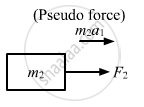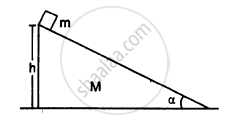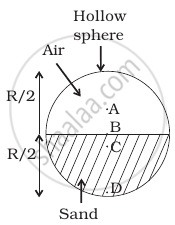Advertisements
Advertisements
प्रश्न
Consider the situation of the previous problem. Suppose the block of mass m1 is pulled by a constant force F1 and the other block is pulled by a constant force F2. Find the maximum elongation that the spring will suffer.
उत्तर
Given:
Force on block of mass, m1 = F1
Force on block of mass, m2 = F2
Let the acceleration produced in mass m1 be a1.
\[a_1 = \frac{F_1 - F_2}{m_1 + m_2}\]
Let the acceleration of mass m2 be a2.
\[a_2 = \frac{F_2 - F_1}{m_1 + m_2}\]
Due to the force F2, the mass m1 experiences a pseudo force.
\[\therefore \text{ Net force on m}_1 = F_1 + m_1 a_2 \]
\[F' = F_1 + m_1 \times \frac{( F_2 - F_1 )}{m_1 + m_2}\]
\[ = \frac{m_1 F_1 + m_2 F_1 + m_1 F_2 - m_1 F_1}{m_1 + m_2}\]
\[ = \frac{m_2 F_1 + m_1 F_2}{m_1 + m_2}\]
Similarly, mass m2 experiences a pseudo force due to force F1.

\[\therefore \text{ Net force on m}_2 = F_2 + m_2 a_1\]
\[F " = F_2 + m_2 \times \frac{( F_1 - F_2 )}{m_1 + m_2}\]
\[ = \frac{m_1 F_2 + m_2 F_2 + m_2 F_1 - m_2 F_2}{m_1 + m_2}\]
\[ = \frac{m_1 F_2 + m_2 F_1}{m_1 + m_2}\]
Let m1 be displaced by a distance x1 and m2 be displaced by a distance x2.
Therefore, the maximum elongation of the spring = x1 + x2
Work done by the blocks = Energy stored in the spring
\[\Rightarrow \frac{m_2 F_1 + m_1 F_2}{m_1 + m_2} \times x_1 \times \frac{m_2 F_1 + m_1 F_2}{m_1 + m_2} \times x_2 = \left( \frac{1}{2} \right)k( x_1 + x_2 )^2 \]
\[ \Rightarrow x_1 + x_2 = \frac{2}{k}\left( \frac{m_1 F_2 + m_2 F_1}{m_1 + m_2} \right)\]
APPEARS IN
संबंधित प्रश्न
You are waiting for a train on a railway platform. Your three-year-old niece is standing on your iron trunk containing the luggage. Why does the trunk not recoil as she jumps off on the platform?
You are holding a cage containing a bird. Do you have to make less effort if the bird flies from its position in the cage and manages to stay in the middle without touching the walls of the cage? Does it makes a difference whether the cage is completely closed or it has rods to let air pass?
A high-jumper successfully clears the bar. Is it possible that his centre of mass crossed the bar from below it? Try it with appropriate figures.
A circular plate of diameter d is kept in contact with a square plate of edge d as show in figure. The density of the material and the thickness are same everywhere. The centre of mass of the composite system will be 
Consider a system of two identical particles. One of the particles is at rest and the other has an acceleration a. The centre of mass has an Acceleration
In which of the following cases the centre of mass of a rod is certainly not at its centre?
(a) the density continuously increases from left to right
(b) the density continuously decreases from left to right
(c) the density decreases from left to right upto the centre and then increases
(d) the density increases from left to right upto the centre and then decreases.
A nonzero external force acts on a system of particles. The velocity and the acceleration of the centre of mass are found to be v0 and a0 at instant t. It is possible that
(a) v0 = 0, a0 = 0
(b) v0 = 0, a0 ≠ 0
(c) v0 ≠ 0, a0 = 0
(d) v0 ≠ 0, a0 ≠ 0
Three particles of masses 1.0 kg, 2.0 kg and 3.0 kg are placed at the corners A, B and C respectively of an equilateral triangle ABC of edge 1 m. Locate the centre of mass of the system.
The structure of a water molecule is shown in figure. Find the distance of the centre of mass of the molecule from the centre of the oxygen atom.

Find the ratio of the linear momenta of two particles of masses 1.0 kg and 4.0 kg if their kinetic energies are equal.
During a heavy rain, hailstones of average size 1.0 cm in diameter fall with an average speed of 20 m/s. Suppose 2000 hailstones strike every square meter of a 10 m × 10 m roof perpendicularly in one second and assume that the hailstones do not rebound. Calculate the average force exerted by the falling hailstones on the roof. Density of a hailstone is 900 kg/m3.
A block of mass 2.0 kg moving 2.0 m/s collides head on with another block of equal mass kept at rest. (a) Find the maximum possible loss in kinetic energy due to the collision. (b) If he actual loss in kinetic energy is half of this maximum, find the coefficient of restitution.
The axis of rotation of a purely rotating body
(a) must pass through the centre of mass
(b) may pass through the centre of mass
(c) must pass through a particle of the body
(d) may pass through a particle of the body.
A block of mass m is placed on a triangular block of mass M which in turn is placed on a horizontal surface as shown in figure. Assuming frictionless surfaces find the velocity of the triangular block when the smaller block reaches the bottom end.

Solve the following problem.
Four uniform solid cubes of edges 10 cm, 20 cm, 30 cm and 40 cm are kept on the ground, touching each other in order. Locate centre of mass of their system.
A bullet of mass 20 gram is fired from a gun of mass 2.5 kg with a speed of 750 m/s. The magnitude of recoil velocity of the gun is ______.
A mass of 1kg is suspended by a string. It is first lifted up with an acceleration of 4.9 m/s2 and then lowered down with same acceleration. The ratio of tensions in the string in the two cases, respectively is g = 9.8 m/s2 ______.
Which of the following points is the likely position of the centre of mass of the system shown in figure?

(n – 1) equal point masses each of mass m are placed at the vertices of a regular n-polygon. The vacant vertex has a position vector a with respect to the centre of the polygon. Find the position vector of centre of mass.
